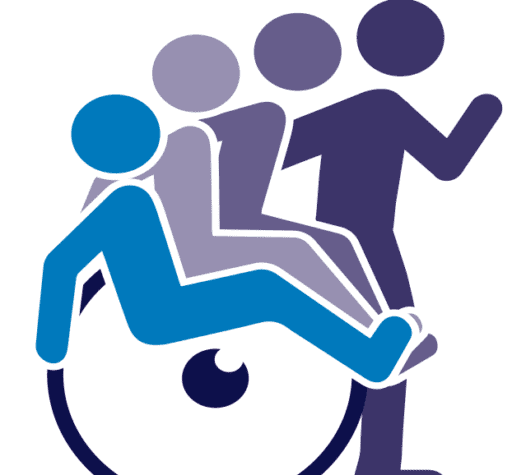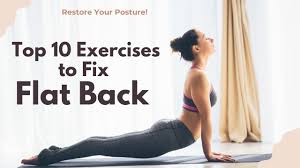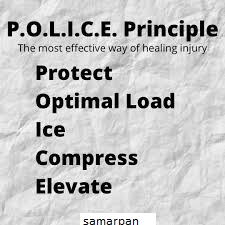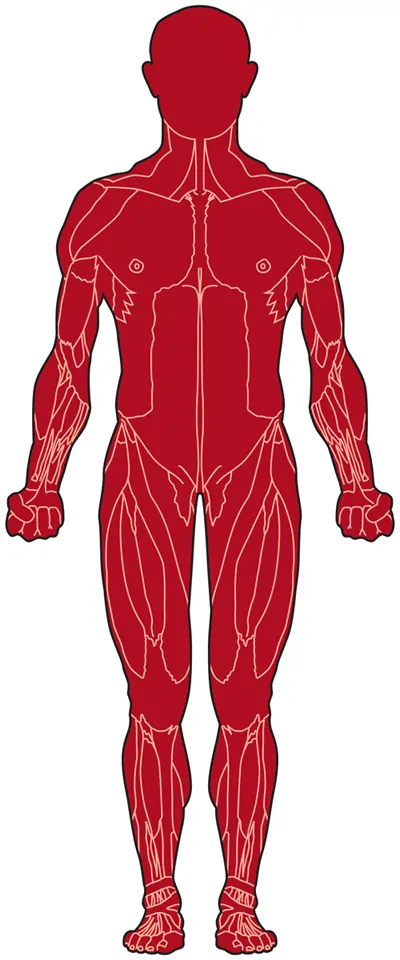Top 10 Exercises to Fix Flat Back Syndrome
Table of Contents
Introduction:
Exercises to Fix Flat Back Syndrome focus on improving spinal mobility, strengthening postural muscles, and restoring the natural curve of the lower back. These exercises help reduce stiffness, correct posture, and relieve discomfort caused by the loss of lumbar lordosis.
A postural disorder known as “Flat Back Syndrome” occurs when the lumbar lordosis, the lower spine’s natural curvature, is diminished or eliminated, giving the appearance of a flat back. pain, stiffness, limited movement, and trouble keeping an erect posture might result from this.
Targeted exercises regularly can help strengthen weak muscles, increase flexibility in tight regions, and realign the spine.
The Top 10 Exercises to Fix Flat Back Syndrome will be covered in this book. These exercises are intended to improve posture, reduce pain, and restore the natural curve of the spine.
Benefits of the Top 10 Exercises for Treating Flat Back Syndrome:
The Top 10 Exercises for Treating Flat Back Syndrome include several significant advantages for enhancing spine health, mobility, and posture. These exercises are intended to alleviate everyday pain, restore the spine’s natural curvature, and address muscular imbalances. Among the main advantages are:
- Strengthens Core and Back Muscles: By using the abdominal, gluteal, and spinal muscles, this exercise helps to stabilize and support the spine.
- Improves Flexibility: It stretches the back muscles, hip flexors, and tense hamstrings that lead to bad posture.
- Reduces Pain and Stiffness: Misalignment-induced lower back pain, tense muscles, and exhaustion are all relieved.
- Improves Postural Awareness: Promotes healthy sitting and standing posture in day-to-day activities.
- Improves Mobility and Balance: Facilitates more fluid, controlled motions, whether standing, walking, or bending.
- Prevents More Complications: Lowers the chance of developing disc issues, chronic back pain, or restricted mobility.
Top 10 Exercises to Fix Flat Back Syndrome Video
Top 10 Exercises to Fix Flat Back Syndrome:
Child’s Pose:
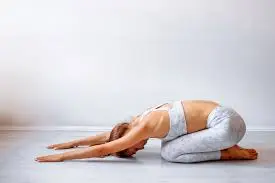
Child’s Pose is a gentle yoga stretch that is highly effective for individuals with Flat Back Syndrome. By stretching the hips, thighs, and spine, Child’s Pose improves flexibility in tight muscles that often contribute to flat back posture, such as the hamstrings and spinal extensors.
It also promotes relaxation, reduces stiffness, and allows the body to naturally realign. Regular practice of this pose not only eases pain but also enhances overall spinal mobility and posture correction.
Cat-Cow Stretch:
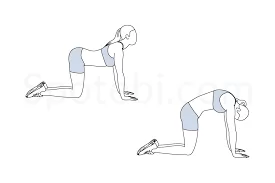
A dynamic exercise that increases spine mobility and flexibility, the cat-cow stretch is particularly helpful in treating flat back syndrome. This exercise helps restore the lumbar spine’s natural curvature by alternating between arching the spine upward (Cat) and lowering it downward (Cow).
In addition to strengthening spinal stabilizers, lowering stiffness, and enhancing circulation to the spine, it gently stretches tense back and abdominal muscles. Regular Cat-Cow practice helps assist the progressive correction of a flattened spine curvature, ease lower back stress, and improve postural awareness.
Cobra Pose:

Because it focuses on restoring the normal lumbar curvature, the Cobra Pose is a great exercise for treating Flat Back Syndrome. This position, which involves resting on the stomach with the spine gently arched backward, opens up the chest, develops the lower back muscles, and relaxes the tight hip flexors and abdominal muscles that frequently cause flat back posture.
It promotes spinal extension, increases frontal body flexibility, and mitigates the negative consequences of extended sitting and slouching.
Bird Dog Exercise:
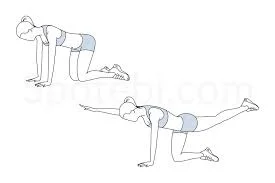
This exercise uses the deep core muscles, glutes, and spinal stabilizers by stretching one arm forward and the opposing leg backward while maintaining a neutral spine. By strengthening these muscles, the spine is kept from collapsing into a flat posture, and the natural lumbar curvature is better supported.
Bird Dog also lessens lower back pain while enhancing balance, coordination, and postural control. Frequent use of this exercise improves mobility, supports good alignment during everyday motions, and strengthens the spine.
Dead Bug Exercise:

Because Dead Bug Exercise strengthens the deep core muscles that support and maintain the spine, it is a very effective way to manage Flat Back Syndrome. It is performed by lying on your back with your arms and legs lifted, then slowly lowering the opposing limbs while maintaining a gentle push of the lower back on the floor. Regular Dead Bug Exercise practice improves core endurance, helps realign the spine, and stops more postural abnormalities.
Bridge Pose:
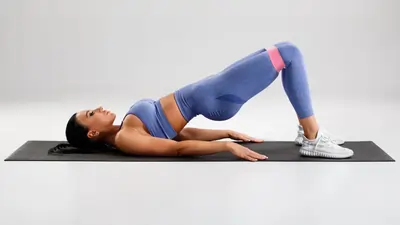
Because it actively develops the hamstrings, glutes, and lower back muscles that support the lumbar curvature, Bridge Pose is a great exercise for treating Flat Back Syndrome. Additionally, it extends the tight hip flexors, which are frequently the cause of the spine’s misalignment. By strengthening the spine’s natural curve, Bridge Pose helps to reduce lower back stress, improve posture, and strengthen the core.
Clamshells:
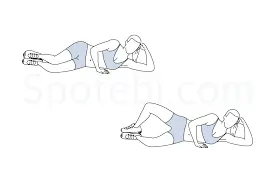
Because they strengthen the gluteus medius and other hip-stabilizing muscles that are essential for maintaining good posture, clamshells are a very helpful exercise for flat back syndrome. Weak glutes often contribute to pelvic misalignment, which can flatten the natural lumbar curve.
Clamshells work the outer hips and glutes by bending the knees while reclining on one side and elevating the upper knee while keeping the feet together. Regular Clamshell exercises improve posture, maintain spinal alignment, and stop further muscle imbalances.
Standing Hip Extension:

Because it strengthens the gluteal muscles and increases hip mobility, two factors crucial to preserving the normal lumbar curve, standing hip extension is a straightforward but powerful exercise for treating flat back syndrome. To stimulate the glutes and hamstrings and promote appropriate pelvic alignment, stand tall and stretch one leg backward without arching the spine.
It assists in reversing the effects of tight hip flexors and weak glutes, which frequently lead to a flat back posture. Regularly performing standing hip extensions improves lower back and hip balance, strengthens the spine, and encourages better posture in day-to-day activities.
Standing Forward Bend Pose:
![Standing Forward Fold Poses[Uttansana]](https://mobilephysiotherapyclinic.net/wp-content/uploads/2023/12/Standing-Forward-Fold-PosesUttansana.webp)
Because it lengthens the spine and eases stiffness in the hamstrings, calves, and lower back, the Standing Forward Bend Pose is a good stretch for those with Flat Back Syndrome. This position increases flexibility in the posterior chain muscles, which frequently limit natural curvature, and promotes moderate spinal decompression by folding the upper body forward from the hips.
Additionally, it eases stiffness, encourages relaxation, and improves blood flow to the legs and spine. The Standing Forward Bend Pose improves posture alignment, supports spinal mobility, and relieves stress when done thoughtfully with a small bend in the knees if necessary.
Seated Spinal Twist
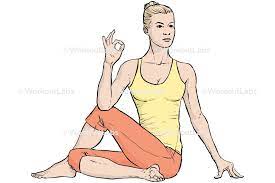
A little yoga practice called the Seated Spinal Twist helps increase spinal flexibility and restore the lower back’s natural curvature, which is frequently diminished in flat back syndrome. This exercise reduces stiffness, increases mobility in the thoracic and lumbar areas, and stretches the muscles along the back by twisting the spine while maintaining a grounded hip position.
Additionally, it works the oblique muscles, which help with posture and spine stability. Regularly performing the Seated Spinal Twist can help release tension, improve spinal alignment, and aid in the recovery of normal spinal curvature.
Conclusion:
Although flat back syndrome can lead to stiffness, soreness, and bad posture, it is feasible to increase general mobility and restore the spine’s natural curvature with the correct exercises.
Together, the Top 10 Exercises, which include posture-improving poses like Standing Forward Bend and Cobra, strengthening exercises like Bird Dog, Dead Bug, Bridge Pose, and Clamshells, and stretches like Child’s Pose and Cat-Cow, correct muscle imbalances, relieve tension, and strengthen the spine.
Regularly performing these exercises improves posture, balance, and everyday movement efficiency in addition to easing pain and stress. These focused exercises can help restore a better spinal alignment and provide long-lasting relief with patience and commitment.
FAQs:
Straight back syndrome can arise from a variety of reasons, but some of the more prevalent ones are spinal disorders, including osteoporosis, degenerative disc disease, ankylosing spondylitis, congenital spinal malformations, and spinal surgery.
One possible cause of flatback syndrome is a history of scoliosis surgery. Because Harrington rods occasionally flattened the spine’s natural swing, the term “flatback syndrome” was first used to characterize those who received them between the 1960s and the early 1990s.
If you use newborn repositioning procedures, you should be able to minimize or treat flat head syndrome. It helps to start early and maintain consistency. Contact your baby’s healthcare professional if moving doesn’t help or if the muscles in their neck appear stiff. A helmet or physical treatment could be beneficial.
When wearing a push-pin style flat back earring, you bend the pin slightly to secure it after inserting it into the backing from the front of your ear. When wearing a flat back earring with a threaded screw, take care not to overtighten the screw since this might harm the earring’s internal threading.
Physical therapy and exercise are typically the first steps in the treatment of flat back syndrome. To improve posture, this usually includes strengthening and stretching activities. Reversing the muscular imbalance pattern that maintains the lower back flat is the aim.
You can regain part of your natural spine curve by exercising to treat a flat back condition. It also reduces the pain associated with pressure on the nerves. Tight hamstrings, weak hip muscles, and weak abdominal muscles are all symptoms of flat back syndrome.
Exercises tailored to a particular condition, such as hamstring and abdominal stretches, can aid in reversing the pattern of muscular imbalances that result in flatback in the lower back. Exercises that are frequently used to strengthen the shoulders, back, neck, buttocks, and core include: Leg lifts performed sideways.
If you’re seeking temporary relief from non-structural back problems, there are effective and safe stretches and exercises that can support a healthy spine, including alignment. The answer is negative, but if the reason is a degenerative structural issue like scoliosis, you should consult a scoliosis expert.
There are safe and efficient stretches and exercises that can help promote a healthy spine, including alignment, if you’re looking for short-term relief from non-structural back issues. However, if a progressive structural condition like scoliosis is the cause, the answer is no; you should seek professional advice from a scoliosis expert.
A person can sleep on their back (supine) with minimal or no cushions beneath their head to reduce neck and back strain. Sleeping on one’s side is also beneficial.
But it may also happen to kids and teens who haven’t fully developed their skeletons yet. This may be caused by injuries, bad posture, or degenerative diseases like arthritis.
Significant pain, impairment, and frustration may result from the disorder. Sometimes, after scoliosis has been treated, flatback syndrome develops. The natural curvature of the back is sometimes straightened out by the rods used to correct the scoliosis’s aberrant curve.
The earring will start to unscrew if you gently twist its two ends in opposing directions. Try using rubber gloves for more traction if you have trouble getting a firm hold.
Two young adult males reported having “flat back syndrome,” which is characterized by significant loss of lumbar lordosis and chronic low back pain linked to anterior sagittal balance. For 16.5–20 weeks, lumbar extension traction was used three to five times a week.
Physical therapy, which includes exercises, painkillers, and instruction for posture and gait, is one of these approaches. Surgery could be necessary if nonoperative treatments are ineffective in relieving symptoms, if the absence of curvature leads to structural issues, or if the misalignment is severe.
References:
- Yashar. (2021, October 4). Best exercises for flat back Syndrome. Yashar Neurosurgery. https://dryashar.com/blog/best-exercises-for-flat-back-syndrome/
- Nalda, T. (2025, February 28). Flat back syndrome – what is it? How to treat it? Scoliosis Reduction Center®. https://www.scoliosisreductioncenter.com/blog/flat-back-syndrome
- FLECT LLC. (2022). Pelvic Clock® Exercises for Flat Back Syndrome. https://static1.squarespace.com/static/55f0c160e4b0cea2feaf393c/t/62e1d044272db41bddaa5256/1658966085992/2022+Flat+Back+Syndrome+-+Pelvic+Clock%C2%AE+Exercises.pdf
- Back Exercises to help relieve back pain non surgically provided by Michael Rohan Spine. (n.d.). https://michaelrohanspine.com/educational_resources/back_exercises.html
- Massage ball stretch. (n.d.). https://www.lakesidechiro.com.au/assets/users/chiro/253/uploads/docs/2019/03/Flat-Back-Syndrome-Exercises.pdf
